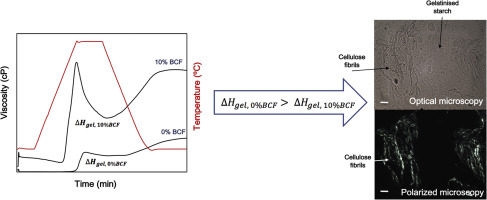当前位置:
X-MOL 学术
›
Food Hydrocoll.
›
论文详情
Our official English website, www.x-mol.net, welcomes your feedback! (Note: you will need to create a separate account there.)
Changes in gelatinisation and pasting properties of various starches (wheat, maize and waxy maize) by the addition of bacterial cellulose fibrils
Food Hydrocolloids ( IF 10.7 ) Pub Date : 2018-07-01 , DOI: 10.1016/j.foodhyd.2018.02.023 P. Díaz-Calderón , B. MacNaughtan , S. Hill , T. Foster , J. Enrione , J. Mitchell
Food Hydrocolloids ( IF 10.7 ) Pub Date : 2018-07-01 , DOI: 10.1016/j.foodhyd.2018.02.023 P. Díaz-Calderón , B. MacNaughtan , S. Hill , T. Foster , J. Enrione , J. Mitchell

|
The aim of this work was to analyse the effect of bacterial cellulose fibrils (BCF) on the gelatinization profile and pasting properties of starches from different sources (wheat, maize and waxy maize) and amylose contents. Blends of 8% starch with different BCF levels (0, 0.5, 2, 6 and 10% based on the dry weight of starch) were prepared and tested by Rapid Visco-Analysis (RVA), Differential Scanning Calorimetry (DSC) and both Optical and Polarized Light Microscopy. Results showed that BCF produce a significant modification of pasting properties. The pasting temperature was reduced but viscosities (peak, final, trough, breakdown and final) increased. The reduction in pasting temperature at the highest BCF addition was 200C higher for maize and wheat starches but only 20C higher for waxy maize starch. In contrast to the pasting temperature, the gelatinisation temperature by DSC for all three starches slightly varied upon BCF addition, but the gelatinisation enthalpy was reduced to a greater extent than values reported for the addition of other hydrocolloids to starch blends. Optical and polarized light microscopy showed the presence of domains rich in starch and highly aggregated BCF in all three starches evaluated. The increase in viscosity and decrease in pasting temperature are discussed in terms of changes in starch concentrations in the starch rich domain. These results open interesting perspectives in the use of bacterial cellulose and plant cell walls to design novel bio-composites to structure foods.
中文翻译:

通过添加细菌纤维素原纤维改变各种淀粉(小麦、玉米和糯玉米)的糊化和糊化特性
这项工作的目的是分析细菌纤维素原纤维 (BCF) 对不同来源(小麦、玉米和蜡质玉米)和直链淀粉含量的淀粉的糊化特性和糊化特性的影响。制备 8% 淀粉与不同 BCF 水平(基于淀粉干重的 0、0.5、2、6 和 10%)的混合物,并通过快速粘度分析 (RVA)、差示扫描量热法 (DSC) 和光学和偏振光显微镜。结果表明,BCF 对粘贴特性产生了显着的改变。糊化温度降低但粘度(峰值、最终、谷值、分解和最终)增加。玉米和小麦淀粉在最高 BCF 添加量下糊化温度降低了 200 摄氏度,但糯玉米淀粉仅高出 20 摄氏度。与粘贴温度相比,通过添加 BCF,所有三种淀粉的 DSC 糊化温度略有不同,但糊化焓降低的程度比将其他水胶体添加到淀粉混合物中报告的值更大。光学和偏光显微镜显示,在评估的所有三种淀粉中都存在富含淀粉的区域和高度聚集的 BCF。粘度的增加和糊化温度的降低是根据富含淀粉的区域中淀粉浓度的变化来讨论的。这些结果为使用细菌纤维素和植物细胞壁设计新型生物复合材料来构建食物开辟了有趣的前景。但是糊化焓降低的程度比将其他水胶体添加到淀粉混合物中所报告的值更大。光学和偏光显微镜显示,在评估的所有三种淀粉中都存在富含淀粉的区域和高度聚集的 BCF。粘度的增加和糊化温度的降低是根据富含淀粉的区域中淀粉浓度的变化来讨论的。这些结果为使用细菌纤维素和植物细胞壁设计新型生物复合材料来构建食物开辟了有趣的前景。但是糊化焓降低的程度比将其他水胶体添加到淀粉混合物中所报告的值更大。光学和偏光显微镜显示,在评估的所有三种淀粉中都存在富含淀粉的区域和高度聚集的 BCF。粘度的增加和糊化温度的降低是根据富含淀粉的区域中淀粉浓度的变化来讨论的。这些结果为使用细菌纤维素和植物细胞壁设计新型生物复合材料来构建食物开辟了有趣的前景。粘度的增加和糊化温度的降低是根据富含淀粉的区域中淀粉浓度的变化来讨论的。这些结果为使用细菌纤维素和植物细胞壁设计新型生物复合材料来构建食物开辟了有趣的前景。粘度的增加和糊化温度的降低是根据富含淀粉的区域中淀粉浓度的变化来讨论的。这些结果为使用细菌纤维素和植物细胞壁设计新型生物复合材料来构建食物开辟了有趣的前景。
更新日期:2018-07-01
中文翻译:

通过添加细菌纤维素原纤维改变各种淀粉(小麦、玉米和糯玉米)的糊化和糊化特性
这项工作的目的是分析细菌纤维素原纤维 (BCF) 对不同来源(小麦、玉米和蜡质玉米)和直链淀粉含量的淀粉的糊化特性和糊化特性的影响。制备 8% 淀粉与不同 BCF 水平(基于淀粉干重的 0、0.5、2、6 和 10%)的混合物,并通过快速粘度分析 (RVA)、差示扫描量热法 (DSC) 和光学和偏振光显微镜。结果表明,BCF 对粘贴特性产生了显着的改变。糊化温度降低但粘度(峰值、最终、谷值、分解和最终)增加。玉米和小麦淀粉在最高 BCF 添加量下糊化温度降低了 200 摄氏度,但糯玉米淀粉仅高出 20 摄氏度。与粘贴温度相比,通过添加 BCF,所有三种淀粉的 DSC 糊化温度略有不同,但糊化焓降低的程度比将其他水胶体添加到淀粉混合物中报告的值更大。光学和偏光显微镜显示,在评估的所有三种淀粉中都存在富含淀粉的区域和高度聚集的 BCF。粘度的增加和糊化温度的降低是根据富含淀粉的区域中淀粉浓度的变化来讨论的。这些结果为使用细菌纤维素和植物细胞壁设计新型生物复合材料来构建食物开辟了有趣的前景。但是糊化焓降低的程度比将其他水胶体添加到淀粉混合物中所报告的值更大。光学和偏光显微镜显示,在评估的所有三种淀粉中都存在富含淀粉的区域和高度聚集的 BCF。粘度的增加和糊化温度的降低是根据富含淀粉的区域中淀粉浓度的变化来讨论的。这些结果为使用细菌纤维素和植物细胞壁设计新型生物复合材料来构建食物开辟了有趣的前景。但是糊化焓降低的程度比将其他水胶体添加到淀粉混合物中所报告的值更大。光学和偏光显微镜显示,在评估的所有三种淀粉中都存在富含淀粉的区域和高度聚集的 BCF。粘度的增加和糊化温度的降低是根据富含淀粉的区域中淀粉浓度的变化来讨论的。这些结果为使用细菌纤维素和植物细胞壁设计新型生物复合材料来构建食物开辟了有趣的前景。粘度的增加和糊化温度的降低是根据富含淀粉的区域中淀粉浓度的变化来讨论的。这些结果为使用细菌纤维素和植物细胞壁设计新型生物复合材料来构建食物开辟了有趣的前景。粘度的增加和糊化温度的降低是根据富含淀粉的区域中淀粉浓度的变化来讨论的。这些结果为使用细菌纤维素和植物细胞壁设计新型生物复合材料来构建食物开辟了有趣的前景。



























 京公网安备 11010802027423号
京公网安备 11010802027423号